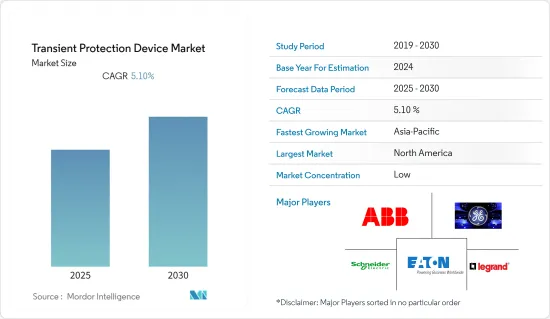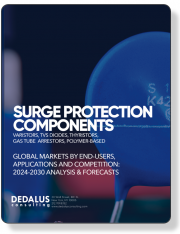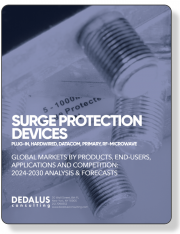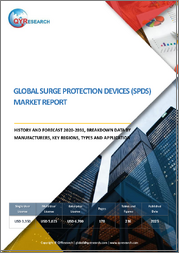
|
시장보고서
상품코드
1635405
과도 보호 디바이스 : 시장 점유율 분석, 산업 동향과 통계, 성장 예측(2025-2030년)Transient Protection Device - Market Share Analysis, Industry Trends & Statistics, Growth Forecasts (2025 - 2030) |
||||||
■ 보고서에 따라 최신 정보로 업데이트하여 보내드립니다. 배송일정은 문의해 주시기 바랍니다.
과도 보호 디바이스 시장은 예측 기간 중 CAGR 5.1%를 기록할 전망

주요 하이라이트
- 미국, 중국, 일본, 인도와 같은 주요 경제 국가들이 여러 산업 분야에서 에너지 효율적인 전기 시스템 개발에 집중하면서 과도 보호 장비에 대한 수요가 급증하고 있습니다. 예를 들어 인도 철도의 한 부서인 RDSO(Research and Development Standardization Organization)는 CAMTECH(Centre for Advanced Maintenance Technology)라는 센터를 개발했습니다. 포함시킴으로써 유지보수 기술과 절차를 업그레이드하고 모든 철도 자산과 인력의 생산성과 성능을 향상시키는 것을 목표로 하고 있습니다.
- 최근 탄소중립 환경을 실현하기 위해 재생에너지에 대한 수요가 증가하면서 전력망의 신뢰도 확보가 중요해지고 있습니다. 또한 대규모 낙뢰에 대한 송변전 설비의 내결함성 강화가 요구되고 있습니다. 이에 따라 과도전류 보호장비에 대한 수요가 증가할 것으로 예상됩니다.
- 또한 스마트 파워탭에 대한 수요 증가도 시장 성장에 기여하고 있으며, Wi-Fi 지원 파워탭은 자동으로 일정과 타이머를 생성하고 에너지 사용량을 모니터링 할 수 있으므로 고객 수요가 높습니다. 이에 따라 여러 업체들이 와이파이 지원 파워탭을 제공하고 고객에게 종합적인 솔루션을 제공하기 위해 노력하고 있습니다. 예를 들어 APC는 3 개의 Lexus 마트 플러그, USB 충전기 포트, 2,160 줄의 스마트 플러그 과도 보호 기능을 갖춘 스마트 과도 보호 Wi-Fi 지원 전원 스트립을 제공합니다.
- 또한 스마트 기기 사용, 스마트홈 기술 및 스마트 시티 프로젝트가 증가함에 따라 스마트홈 지원 과도 보호 장비에 대한 수요가 증가할 것으로 예상됩니다. 예를 들어 미국 에너지부(DOE)는 2021년 10월, 신기술을 활용하여 수천 개의 가정과 기업을 첨단 에너지 효율 구조로 전환하는 10개의 시범 프로젝트에 6,100만 달러를 배정할 것이라고 발표했습니다. 이러한 커넥티드 커뮤니티는 전력망과 통신하여 에너지 소비를 최적화하고 탄소 배출량과 에너지 가격을 낮출 수 있습니다.
- 그러나 보호 수준이 높은 소형 과도 보호 장비 설계의 과제는 시장 성장을 저해할 가능성이 높습니다. 예를 들어 고성능 과도 보호 장비에는 많은 수의 부품이 포함되어 있으며, 회로 내에 병렬로 배열되어 있어야 합니다. 개별 서프레션 부품은 기계적인 설계 결함으로 인해 인접한 부품보다 더 큰 에너지를 견뎌야 할 수 있으며, 이는 이론적 모델과 실제 장비 간의 성능 수준 차이를 유발할 수 있습니다.
- 또한 COVID-19 팬데믹은 장비 생산 공급에 심각한 영향을 미쳐 과도 보호 장비 시장의 성장에 부정적인 영향을 미쳤습니다. 또한 현장 접근성 부족과 원자재 부족으로 인해 과도 보호 장비를 포함한 다양한 전자 부품 제조업체는 단기적인 운영상의 어려움에 직면했습니다.
과도 보호 장비 시장 동향
스마트 시티의 과도전류 보호 장비 수요 증가로 시장 성장 견인할 전망
- 중국 정부는 일대일로 구상(Belt and Road Initiative)의 디지털 실크로드 구상(Digital Silk Road Initiative)의 일환으로 스마트 시티와의 협력을 일상적으로 장려하고 있습니다. 전략적 파트너십 비전 2030을 통해 강화되고 있으며, 중국은 아세안 ICT 마스터플랜 2020, 아세안 스마트 시티 네트워크 등 아세안의 기술 혁신을 위한 구상을 지원할 것을 표명하고 있습니다.
- 또한 미국 지역의 여러 정부도 스마트 시티 도입을 추진하고 있습니다. 예를 들어 라스베가스에서는 3개의 파일럿 프로젝트를 테스트하고 있으며, 정부는 5억 달러를 할당하여 2025년까지 도시 전체를 연결하는 방법을 모색하고 있습니다.
- 아시아개발은행(ADB)에 따르면 동남아시아국가연합(ASEAN)을 구성하는 국가 인구의 약 절반이 도시에 거주하고 있으며, 2025년까지 7,000만 명이 추가로 도시 거주자가 될 것으로 예상되고 있습니다. 따라서 아세안의 지속가능한 도시화 전략은 이러한 도시화 문제를 해결하기 위한 해결책으로 스마트 시티 프로젝트와 스마트 빌딩과 같은 기술 발전을 인정하고 있습니다. 이러한 구상은 국제적인 투자에 의해 지원되고 있으며, OECD는 2010-2030년 사이에 모든 도시 인프라 프로젝트에 총 1조 8,000억 달러가 투자될 것으로 추정하고 있습니다. 디지털화된 인프라에 대한 투자가 수요를 견인하고 자산 보안에 대한 필요성이 증가할 것으로 예상됩니다.
- 스마트 빌딩에는 온도 제어, 멀티미디어 시스템, 통신, 보안 시스템 등 다양한 자동 시스템이 상호 연결된 다양한 자동 시스템이 사용되며, 특히 뇌우와 조명에 영향을 받기 쉽습니다. 그 결과, 전력 공급 라인뿐만 아니라 데이터 라인을 통해 구조물에 침입하는 과도 현상은 컴퓨터, 경보 시스템, 변환기, PLC, AV 장비 등 다양한 고감도 전자 장비에 악영향을 미칠 수 있습니다. 한편, 네트워크화된 컴포넌트는 지속적인 기능과 가용성을 위해 지속적인 전력 및 데이터 공급에 의존하므로 일반적으로 낙뢰 및 과도현상에 특히 취약합니다.
- 또한 스마트 빌딩의 장비 고장은 상호 연결된 모든 시스템을 중단시켜 건물 및 작업 환경의 파괴와 관련 비용을 초래할 수 있습니다. 강력한 과도 보호 장비를 시스템에 통합하면 이 모든 것을 제거하거나 줄일 수 있습니다. 과도 전류 보호 장비는 스마트 빌딩에 사용되는 스마트 기기의 전원 관리에도 사용됩니다.
아시아태평양이 괄목할 만한 성장을 이룰 것으로 예상
- 아시아태평양은 인구의 생활 수준 향상, 가처분 소득 증가, 스마트홈 채택 증가로 인해 과도 전류 보호 장비 시장의 견고한 성장을 목격하고 있습니다. 예를 들어 인도 통계 및 계획 실행부에 따르면 인도의 가처분 개인 소득은 2020년 1억 9,968만 9,740 루피에서 2021년에는 2억 3,857만 3,760 루피로 증가할 것으로 예상됩니다. 또한 일본 통계청에 따르면 일본의 가처분 소득은 2022년 4월 43만 6,850엔에서 5월 35만 9,510엔으로 감소했습니다.
- 이 지역의 스마트홈 시장에 영향을 미치는 주요 요소는 스마트 전자 제품의 적용으로 에너지 효율적인 조명 및 보안 솔루션에 대한 요구가 증가하여 과도 보호 장비 시장을 촉진하고 있습니다. 예를 들어 중국에서는 주택도시농촌개발부와 공안부가 공동으로 디지털 주택 개발 가속화를 위한 권고안을 발표했으며, 2022년 말까지 디지털 주택에 대한 정책, 방법, 표준을 마련해야 한다고 밝혔습니다.
- 또한 인더스트리 4.0은 원격 데이터 수집, 원격 진단, 원격 유지보수를 가능하게 하기 위해 자동차 및 전기 기계에 적용되고 있습니다. 이러한 노력으로 인해 데이터센터, 서버, 통신 시스템의 필요성이 증가하고 있습니다. 예를 들어 중국에서는 정부 당국의 지원을 받아 데이터센터가 성장하고 있습니다. 최근 중국 정부는 3개년 계획(2021-2023년)을 발표하며 2023년까지 200 엑사플롭스(Exaflops)의 데이터센터 컴퓨팅을 실현하겠다고 밝혔습니다. 또한 하이퍼스케일 데이터센터를 장려하는 정부 기관의 조치도 데이터센터 건설에 힘을 실어주고 있습니다. 예를 들어 2021년 4월 인도 전자정보기술부(MeitY)는 국내 하이퍼스케일 데이터센터 투자에 대한 인센티브를 제공하고 단기간에 현재 용량을 10배 이상 증가시킬 수 있는 제도를 개발할 계획이라고 발표했습니다. 이 지역의 데이터센터 증가는 간접적으로 이 지역의 과도 전류 보호 장비의 성장을 가져왔습니다.
- 또한 이 지역의 디지털 혁신도 시장 성장을 가속하고 있습니다. 예를 들어 2022년 5월에 개최된 화웨이 아시아태평양 디지털 혁신 회의(Huawei Asia Pacific Digital Innovation Congress)에는 아시아태평양 10개국 이상에서 1,500명 이상이 모여 디지털 혁신과 디지털 경제의 미래에 대해 논의했습니다. 화웨이와 아세안 재단이 공동 주최한 이 행사에는 정부 관계자, 전문가, 연구자, 파트너, 애널리스트 등이 참석했습니다. 이 지역에서의 이러한 노력은 아시아태평양의 과전류 보호 장비 시장의 성장 잠재력을 보여줍니다.
- 또한 중국의 건축 기술의 발전은 이 지역의 과도 전류 보호 장비 시장을 주도하고 있습니다. 예를 들어 2021년 2월 히타치 빌딩 테크놀러지와 차이나 통신 광저우(China Telecom Guangzhou)는 중국 건물 및 복합 시설에 통합 보안, 에너지 및 장비 관리 서비스를 제공하는 보다 스마트하고 효율적이며 안전한 제품 및 서비스를 제공하는 스마트 빌딩 솔루션 개발을 위해 협력하는 양해각서를 체결했습니다. 인프라 지원 및 최적화, 업그레이드, 통합에 중점을 둡니다.
과도 보호 장비 산업 개요
과전류 보호 장비 시장은 경쟁이 치열하고 여러 대기업으로 구성되어 있으므로 매우 세분화되어 있습니다. 시장에서 경쟁 기업 간의 적대적 관계는 신제품 개발, 생산 능력 확장, 인수 합병, 전략적 제휴, 파트너십, 협정, 연구개발 활동에 대한 투자 등 기업의 적극적인 전략에 달려 있습니다.
- 2022년 5월 - 과도 전류 보호 장비 제조업체인 Legrand는 인도 최초의 소매점인 Legrand Studio를 하이데라바드에 오픈했습니다. 이 대규모 소매점은 인도에서 르그랑의 발자취를 강화하기 위해 르그랑의 인도 그룹 회사의 모든 제품을 취급합니다. 또한 Legrand는 인도에 Innova, Studio, Shop-in-Shop 형식을 포함한 30개 이상의 인터랙티브 제품 쇼룸을 보유하고 있습니다.
- 2022년 3월 - 고성능 스피커 제조업체로 잘 알려진 ELAC는 트랜스젠트 프로텍트 프로텍트 시리즈로 장비 보호 제품 부문에 진출할 계획을 발표했습니다. 제품 라인을 만들기 시작했습니다. 앱 제어, Wi-Fi, 블루투스, 알렉사/구글 어시스턴트 지원으로 시장의 많은 경쟁 제품들과 차별화됩니다.
기타 혜택
- 엑셀 형식의 시장 예측(ME) 시트
- 3개월간의 애널리스트 지원
목차
제1장 서론
- 조사의 전제조건과 시장 정의
- 조사 범위
제2장 조사 방법
제3장 개요
제4장 시장 인사이트
- 시장 개요
- 산업의 매력 - Porter's Five Forces 분석
- 공급 기업의 교섭력
- 소비자의 교섭력
- 신규 진출업체의 위협
- 대체품의 위협
- 경쟁 기업 간 경쟁 관계
- 산업 밸류체인 분석
- 산업에 대한 COVID-19의 영향 평가
제5장 시장 역학
- 시장 성장 촉진요인
- 다양한 정부에 의한 공공안전 규제의 지속적 변경
- 스마트 시티에서 과도 보호 디바이스의 요구 증가가 시장의 성장을 촉진할 전망
- 시장 성장 억제요인
- 보호 레벨을 강화한 소형 과도 보호 디바이스의 개발 과제
제6장 시장 세분화
- 유형별
- AC 과도 보호 시스템
- DC 과도 보호 시스템
- 산업별
- 산업용
- 상업용
- 주택용
- 지역별
- 북미
- 유럽
- 아시아태평양
- 라틴아메리카
- 중동 및 아프리카
제7장 경쟁 구도
- 기업 개요
- ABB Ltd
- General Electric Company
- Schneider Electric SE
- Eaton Corporation
- Legrand S.A.
- Siemens AG
- Emerson Electric Co.
- CG Power and Industrial Solutions
- Littelfuse
제8장 투자 분석
제9장 시장 전망
KSA 25.01.31The Transient Protection Device Market is expected to register a CAGR of 5.1% during the forecast period.

Key Highlights
- The focus of major economies like the United States, China, Japan, India, etc., on developing energy-efficient electrical systems across multiple industrial sectors is adding to the upsurge in demand for transient protection devices. For instance, the Research Designs and Standards Organization (RDSO), a unit of the Indian Railways has developed a center called CAMTECH (Centre for Advanced Maintenance Technology). CAMTECH aims to increase the productivity and performance of all railway assets and workforce by upgrading maintenance technologies and procedures by including lightning and transient protection device arrangements in integrated power supply for signalling installations.
- In recent years, to achieve carbon neutral environment, the demand for renewable energy has increased, and ensuring the reliability of power grids has become more important. In addition, there is a requirement to enhance the resilience of transmission and substation equipment for large-scale lightning strikes. Resultantly, the demand for transient protection devices is expected to witness an uptick.
- Additionally, the rising demand for smart power strips is also contributing to boost the market's growth. Customers are in great demand for Wi-Fi-enabled power strips due to their ability to automatically create schedules, timers, and monitor energy usage. Therefore, several businesses are working towards offering Wi-Fi-enabled power strips, to serve as a comprehensive solution to their customers. For instance, APC is offering a smart transient protection WI-FI enabled Power strip with 3 Alexa Smart Plugs, USB Charger Ports, and 2160 Joules of Smart Plug transient Protection.
- Further, the need for smart home-enabled transient protection devices is predicted to rise with the rise in smart gadget use, smart home technology, and smart city projects. For instance, in October 2021, the US Department of Energy (DOE) announced the allocation of USD 61 million to ten pilot projects that would use new technologies to turn thousands of homes and businesses into advanced, energy-efficient structures. These Connected Communities may communicate with the electrical grid to optimize their energy consumption, lowering carbon emissions and energy prices.
- However, the challenges in designing compact transient protection devices with enhanced protection levels will likely restrain the market's growth. For example, high functional transient protection devices include numerous components that must be placed in parallel arrays in the circuit. Individual suppression components may have to endure greater energy than the adjacent due to poor mechanical design, and this is causing fluctuations in the performance level between the theoretical model and real devices.
- Moreover, the COVID-19 pandemic also has had a negative impact on the Transient Protection Device market's growth by severely impacting the supply for the device production. Further, due to a lack of site access and deficiencies in raw materials, manufacturers of various electronic components, including transient protection devices, faced short-term operational challenges.
Transient Protection Device Market Trends
An Increase in the Need for Transient Protection Devices in Smart Cities is Expected to Drive the Market's Growth
- The Chinese government routinely encourages smart city collaboration as part of the Belt and Road Initiative's Digital Silk Road Initiative. Cooperation within ASEAN is strengthened by the ASEAN-China Strategic Partnership Vision 2030, whereby China has vowed to support ASEAN's initiatives for technological transformation, such as the ASEAN ICT Master Plan 2020 and the ASEAN Smart City Network.
- Furthermore, various governments in the American region are also boosting the adoption of smart cities. For instance, Las Vegas is testing three pilot projects, with the government allocating USD 500 million to find ways to connect the entire city by 2025.
- According to Asian Development Bank, about half of the population in the countries making up the Association of Southeast Asian Nations (ASEAN) live in urban areas, and 70 million more people are expected to become urban dwellers by 2025. Hence, the ASEAN Sustainable Urbanization Strategy recognizes technological advancements such as smart city projects and smart buildings as a solution to tackle these urbanization challenges. These initiatives are supported by international investments, which the OECD estimates will total around USD 1.8 trillion for all urban city infrastructure projects between 2010 and 2030. The demand is anticipated to be driven by the investment in digitized infrastructure, which would increase the need for asset security.
- A broad variety of interconnected automatic systems such as temperature control, multimedia systems, telecommunications, and security systems are used in smart buildings that are particularly sensitive to the effects of thunderstorms and lighting. As a result, any transient that enters the structure, not only through the power supply lines but also through the data lines, might harm a wide range of sensitive electronic equipment, including computers, alarm systems, transducers, PLCs, and audio-visual equipment. Networked components, on the other hand, are particularly vulnerable to lightning strikes and transients in general since they rely on a continual supply of power and data for their continued functioning and availability.
- Moreover, failure of equipment in a smart building could bring all interconnected systems to a halt, resulting in the breakdown of buildings and work environments, as well as the related expenses. These all can be eliminated or can be reduced by integrating powerful transient protection devices into the systems. Transient protection devices are also used in power management for smart equipment used in smart buildings.
Asia-Pacific is Expected to Witness a Significant Growth
- The APAC region is witnessing a robust growth in the transient protection devices market owing to the enhanced living standards of the population, rising disposable income, and increasing adoption of smart homes. For instance, according to the Ministry of Statistics and Programme Implementation, Disposable Personal Income in India increased to INR 23,85,73,760 Million in 2021 from INR 19,96,89,740 INR Million in 2020. Furthermore, According to the Statistics Bureau of Japan, Disposable Personal Income in Japan decreased to JPY 359.51 Thousand in May from JPY 436.85 Thousand in April 2022
- The key element impacting the market for smart homes in the region is the increased desire for energy-efficient lighting and security solutions through the application of smart electronic products, boosting the transient protection device market. For example, in China, the Ministry of Housing and Urban-Rural Development and the Ministry of Public Security jointly released recommendations on speeding the development of digital houses, stating that policies, methods, and standards for digital homes should be in place by the end of 2022.
- Additionally, the Industry 4.0 initiative is being applied to vehicles and electrical machinery to enable remote data capture, remote diagnostics, and remote maintenance. Such initiatives have augmented the need for data centers, servers, and communication systems. For Instance, China has been growing in data centers with support from governmental authorities. Recently, the Chinese government issued a three-year plan (2021-2023) which calls for 200 exaflops of data center computing by 2023. Furthermore, The government bodies' steps to incentivize hyper-scale data centers are also driving their construction. For instance, in April 2021, the Indian Ministry of Electronics and Information Technology (MeitY) announced that it plans to develop a scheme to incentivize investments in hyper-scale data centers in the country and increase the current capacity over ten-fold in a short period. Rising of Data Centers in the region is indirectly causing the growth of Transient protection devices in the region.
- In addition, the digital transformation in the region is also driving the market growth. For instance, in May 2022 the Huawei APAC Digital Innovation Congress brought together over 1500 people from over ten nations in APAC to discuss the future of digital innovation and the digital economy. The event is co-hosted by Huawei and the ASEAN Foundation, with government officials, specialists, researchers, partners, and analysts among the attendees. These initiatives in the region show the potential for growth of the transient protection device market in the APAC region.
- Moreover, the rising of building technology in China is driving the transient protection device market in the region. For instance, in February 2021, Hitachi Building Technology and China Telecom Guangzhou signed an MOU to work cohesively to develop smart building solutions to provide smarter, more efficient, and secure products & services that will provide unified security, energy, and device management services to buildings and complexes in China. With a focus on infrastructure support and optimization, upgrading, and integration of infrastructure.
Transient Protection Device Industry Overview
The Transient Protection Device market is highly fragmented, as the market is highly competitive and consists of several major players. The competitive rivalry in the market depends on the company's aggressive strategies in new product development, capacity expansion, mergers and acquisitions, strategic collaborations, partnerships, and agreements, as well as investment in R&D activities.
- May 2022 - Legrand a manufacturer of transient protection devices opened its first retail shop in India, the Legrand Studio in Hyderabad. This mega retail store would house all of Legrand's India group company's products with the goal of strengthening Legrand's footprints in the country. In addition, Legrand has over 30 interactive product showrooms in India, including Innova, Studio, and Shop-in-Shop formats.
- March 2022 - ELAC, a well-known high-performance speaker manufacturer announced its plans to enter the equipment protection product area with the Protek line of transient protectors. ELAC set out to create a line of equipment protection devices with more modern features and greater performance levels. App control, Wi-Fi, Bluetooth, and Alexa / Google Assistant compatibility set it apart from much of the competition in the market.
Additional Benefits:
- The market estimate (ME) sheet in Excel format
- 3 months of analyst support
TABLE OF CONTENTS
1 INTRODUCTION
- 1.1 Study Assumptions and Market Definition
- 1.2 Scope of the Study
2 RESEARCH METHODOLOGY
3 EXECUTIVE SUMMARY
4 MARKET INSIGHTS
- 4.1 Market Overview
- 4.2 Industry Attractiveness - Porter's Five Forces Analysis
- 4.2.1 Bargaining Power of Suppliers
- 4.2.2 Bargaining Power of Consumers
- 4.2.3 Threat of New Entrants
- 4.2.4 Threat of Substitutes
- 4.2.5 Intensity of Competitive Rivalry
- 4.3 Industry Value Chain Analysis
- 4.4 Assessment of COVID-19 impact on the industry
5 MARKET DYNAMICS
- 5.1 Market Drivers
- 5.1.1 The Ongoing Changes That Various Governments Are Making to Their Public Safety Regulations
- 5.1.2 An Increase in the Need for Transient Protection Devices in Smart Cities is Expected to Drive the Market's Growth
- 5.2 Market Restraints
- 5.2.1 Design Challenge to Develop Smaller Size Transient Protection Devices With Enhanced Protection Level
6 MARKET SEGMENTATION
- 6.1 By Type
- 6.1.1 AC Transient Protection System
- 6.1.2 DC Transient Protection System
- 6.2 By End-user Verticals
- 6.2.1 Industrial
- 6.2.2 Commercial
- 6.2.3 Residential
- 6.3 By Geography
- 6.3.1 North America
- 6.3.2 Europe
- 6.3.3 Asia Pacific
- 6.3.4 Latin America
- 6.3.5 Middle East and Africa
7 COMPETITIVE LANDSCAPE
- 7.1 Company Profiles
- 7.1.1 ABB Ltd
- 7.1.2 General Electric Company
- 7.1.3 Schneider Electric SE
- 7.1.4 Eaton Corporation
- 7.1.5 Legrand S.A.
- 7.1.6 Siemens AG
- 7.1.7 Emerson Electric Co.
- 7.1.8 CG Power and Industrial Solutions
- 7.1.9 Littelfuse
8 INVESTMENT ANALYSIS
9 FUTURE OUTLOOK OF THE MARKET
샘플 요청 목록



















